I enjoy pistol-caliber carbines. I understand the complaints and reasons why others aren’t fans of them. I find them so much fun and cheaper to shoot than my 5.56 and .308 caliber rifles. They tend to be easy to suppress, and I can shoot at most indoor ranges, as well as being able to be fairly close to steel targets when shooting.
What’s my favorite PCC? Currently, it’s the CMMG MkGs Resolute.
There are a few things to unpack there. The MkGs means it takes GLOCK magazines. Resolute means it’s a full-sized rifle. Not a braced AR pistol, but a full-sized AR rifle chambered in 9mm…and it takes GLOCK mags.
For some, that seems silly but for me, it was the perfect platform for a competition rifle. I’ve been shooting a lot of Steel Challenge and Action Steel Matches as of late, and my CMMG MkGs has been my go-to.
The CMMG MkGs Up Close
The CMMG MkGs use the radial delayed blowback system that has made CMMG’s PCCs and braced pistols tough to beat. Most ARs in 9mm are straight blowback-operated weapons, meaning the breech isn’t locked. Instead, it’s held closed by a mixture of a heavy bolt, buffer, and buffer spring. These 9mm carbines aren’t shoulder beaters, but they have more recoil than a 9mm rifle should.

The radial delayed system of the CMMG series is a locked breech system. The bolt is nearly identical to a standard 5.56 bolt. Its like they used an AR-15 jig to mold it. The bolt has teeth, but those teeth are trimmed at an angle, locked into the chamber of the gun. When it’s fired, the bolt spins and unlocks and allows the rifle to cycle. This system means the gun doesn’t need any heavy bolts, buffers, or springs.
The rifle itself features a free-float M-LOK handguard that’s ultra-lightweight. The barrel has the CMMG Zeroed Muzzle Brake. We get an ambidextrous safety with a short throw and an ambi charging handle.
CMMG uses a Texas-sized bolt release along with that Texas-sized charging handle. The magazine release is pressed rearward, so it works with GLOCK mags, and the gun has a last-round bolt hold open device.
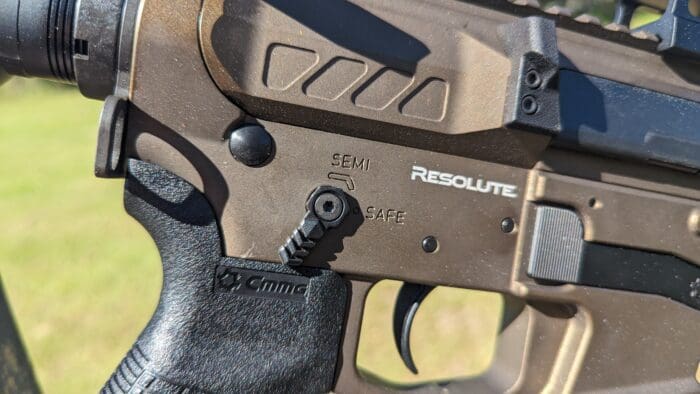
The MkGs also comes with CMMG’s rip stock. The rip stock allows for instant deployment from a close position. Just grip and rip. The Ripstop comes with a set screw that allows you to set the stock to the position you prefer.
The MkGs In Competition
In my first-ever match, I used the MkGs and came in third. I took that as an absolute win. When I shot my first Action Steel match, I didn’t even know what the red line around the shooting position meant. I was a bit clueless. Still, taking third is a testament to this rifle’s handling and capabilities.
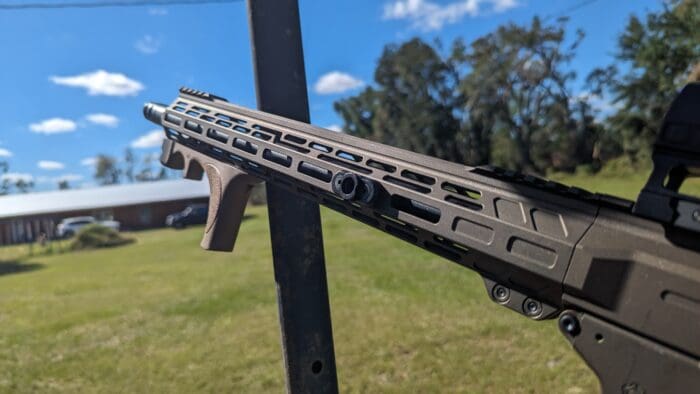
The first big advantage it gave me over other shooters was its almost complete lack of recoil. Compared to a blowback rifle, the Resolute might as well be shooting rimfire. It doesn’t PEW its pews. The radial delayed blowback system works wonderfully and the brake also likely gives the gun a little help in the recoil department.
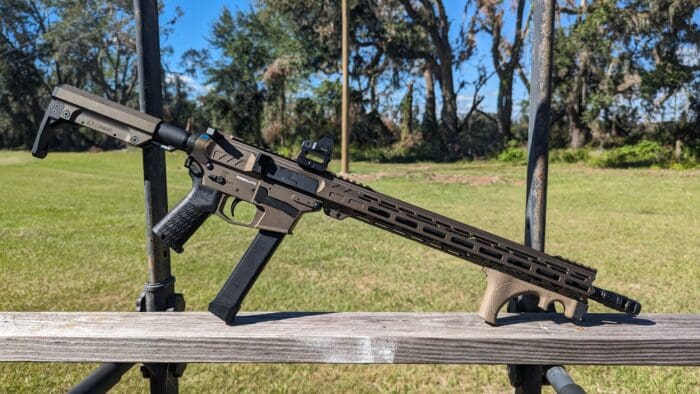
Accuracy is also excellent. I topped the gun with a ZeroTech red dot. The lightweight dot compliments the rifle and its purpose really well. At 50 yards with a benched rifle, I can create groups averaging about 1.6 inches. Sure, that’s not 1 MOA, but pistol rounds aren’t exactly the most stable rounds for longer-range shooting.
The trigger is MIL-SPEC-ish. It’s not super light, but there’s no grit or take-up, just a stiff wall before the break.
From a practical perspective, the Resolute shoots straight and does it quickly. It’s very easy to swing from target to target, both big and small, and keeps your rounds flowing down range. Squeezing off a dozen rounds barely moves the gun, so hitting an A-zone twice isn’t much of a challenge.
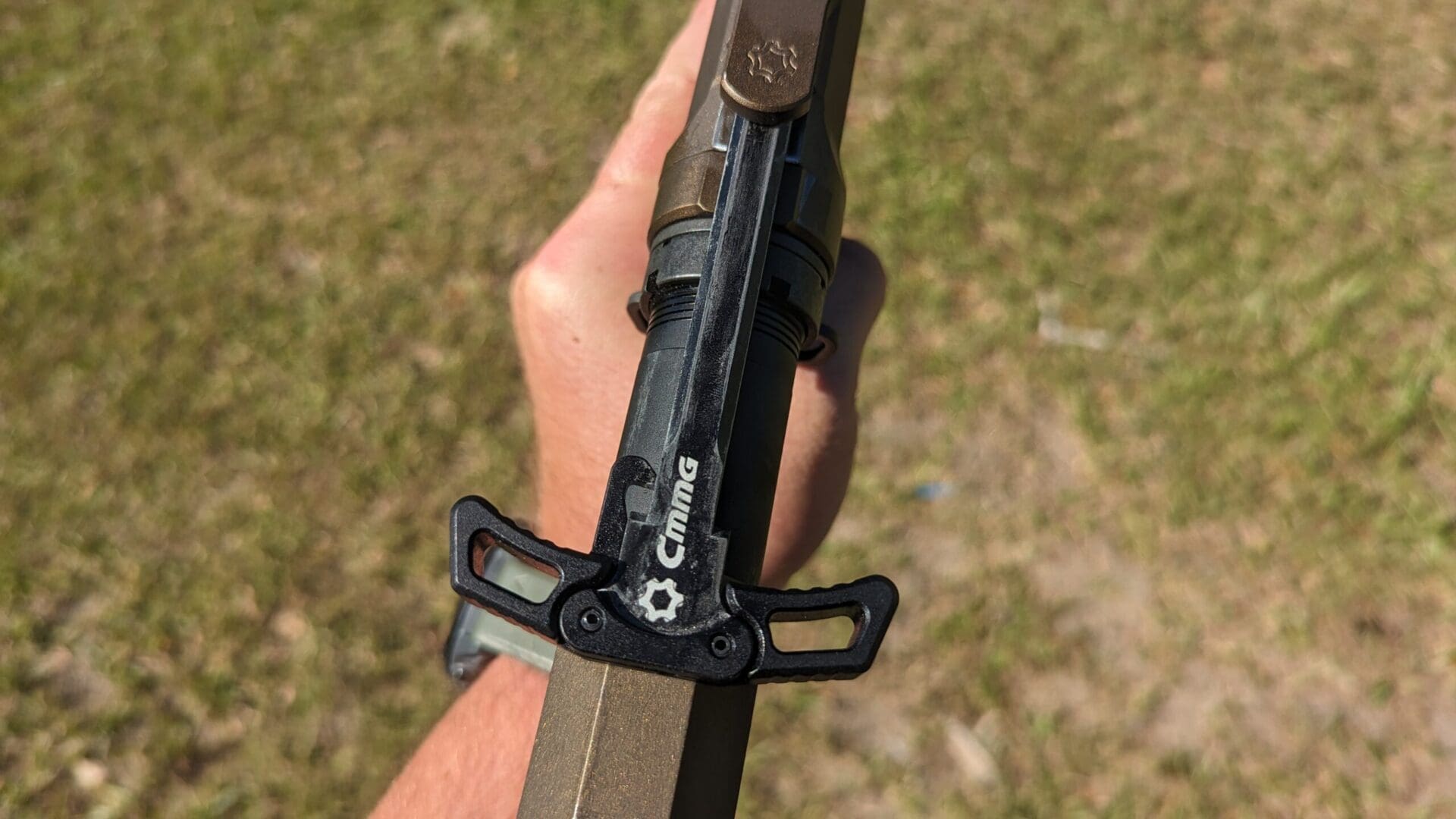
Reloading and Reliability
Rarely do I ever have to reload in a PCC competition. A 33-round GLOCK mag is often plenty. When I do have to reload or when I practice reloading, the process is super easy.
The fact that the bolt locks open on the last round is nice and not always a feature of PCCs that use GLOCK magazines. The magwell is beveled, and that helps in quickly feeding the rifle. That big bolt release takes a palm nicely and sends the bolt home.
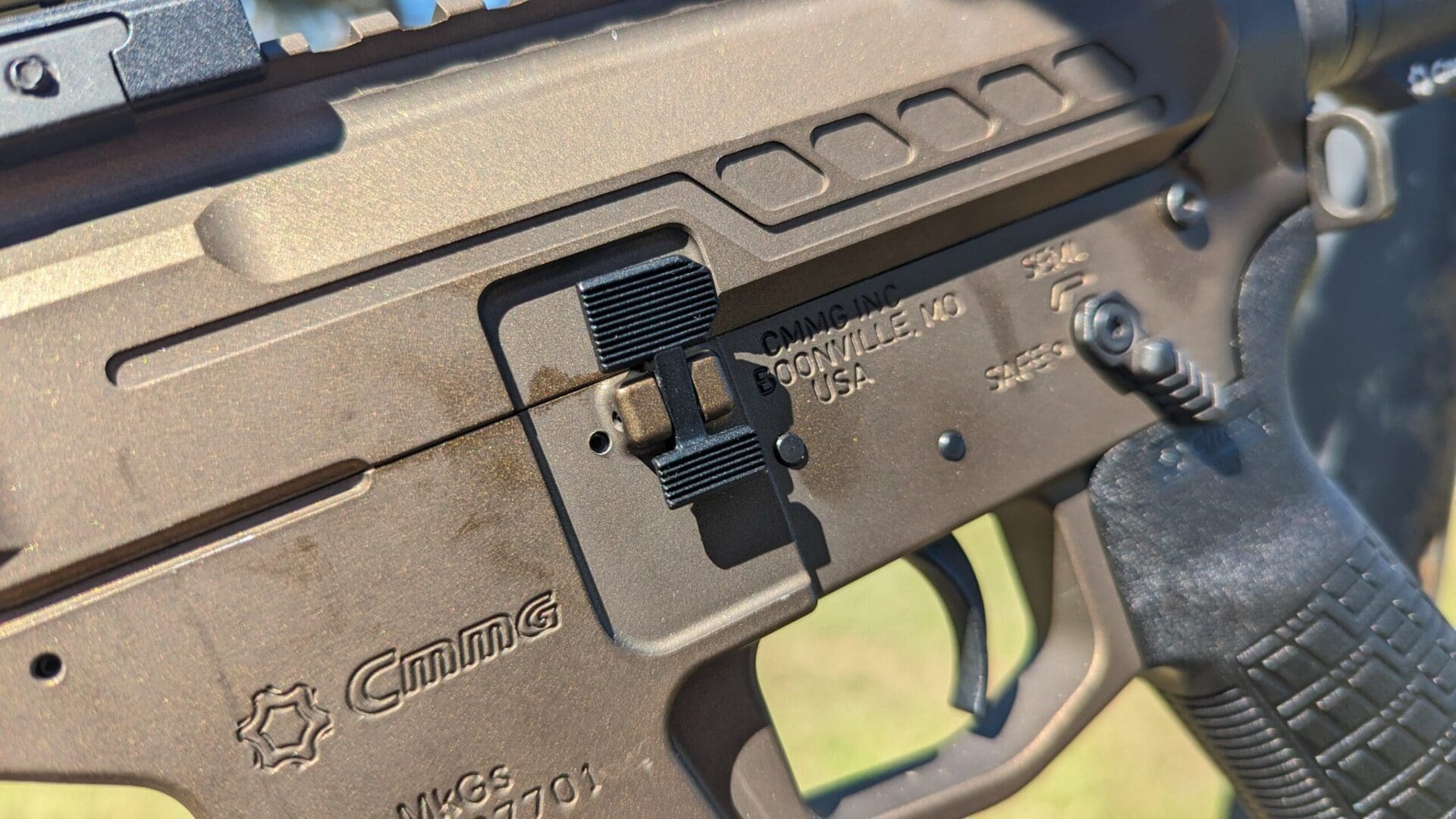
Magazines will seat without a problem on a closed bolt, except for the Magpul D50 9mm drum. It will seat, but needs a firm hand to make it so. It’s much easier to shove into a magwell with an open bolt.
Most of the time, I get a gun, I get the ammo for it, and I set it aside. This way I can track the ammo utilized by the gun during a review. I don’t have that exact information for the MkGs because I’ve shot it an absolute ton. Well over a thousand rounds by now. I clean it…sometimes. It’s not really a maintenance-heavy gun.
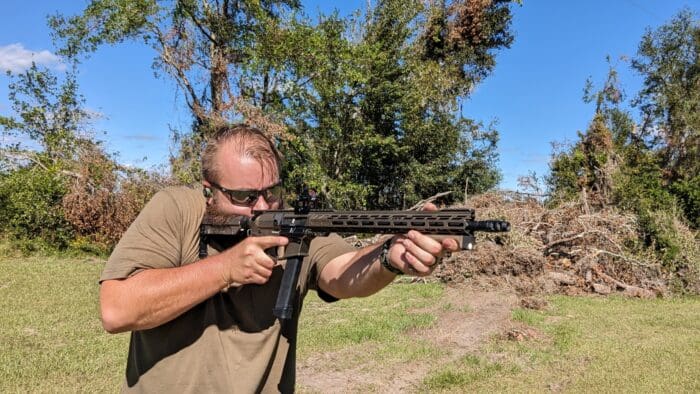
I haven’t had a single malfunction with the gun that wasn’t ammo-related. Heck, I haven’t even run into hard primer issues. I had a few rounds with projectiles seated too deeply and one projectile that just separated from the case when it was its turn to empty the chamber. I blame stage fright and the fact that Winchester White Box ain’t what it used to be.
A Resolute Revolution
The CMMG Resolute MkGs is one helluva rifle. My wife and older kiddos really enjoy it. It’s soft-shooting and lightweight. PCCs are optimum for home defense ballistically, but can be optimum ergonomically for a lot of users. For competition shooting, the Resolute is just right. It’s not the cheapest option, but it seems to be the most affordable non-blowback gun.
My only complaint regarding the MkGs is the stock. It doesn’t offer sling points and it pulls on my beard like a beast.
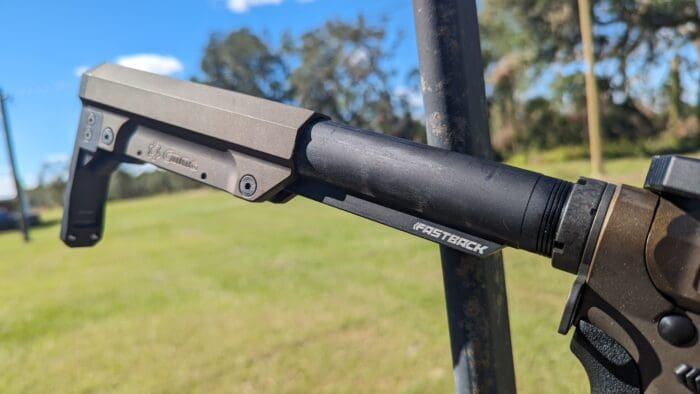
Other systems like gas pistons and roller-delayed blowback guns cost more than the radial delayed systems. This particular model and I will likely be together for quite some time, and it’s going to remain my favorite PCC (until I start losing more and need to blame something besides myself).
Specifications: CMMG Resolute MkGs
Barrel Length – 16.1 inches
Overall Length – 32.5 inches
Weight – 6.4 pounds
Caliber – 9mm
Capacity – 10 to 50
MSRP – 1,799.95 (Street Price $1,650-ish)
Ratings (Out of Five Stars):
Accuracy * * * * ½
For a PCC, the MkGs is quite accurate. It does everything it can with the 9mm round. Best of all, it’s fast and accurate.
Ergonomics * * * * *
The CMMG MkGs Resolute is a very easy-to-handle rifle with excellent controls and ergonomics. It’s all laid out really well, and the controls are quite large and easy to use.
Reliability * * * * *
It’s never let me down, either during training and practice or in the middle of a match.
Ease of Use * * * * *
The CMMG Resolute MkGs has so little recoil and muzzle rise that it could be a great home defense weapon for smaller shooters. It’s a very friendly for new and smaller shooters.
Overall * * * * ½
The Resolute MkGs is my personal favorite PCC. It’s a very easy-shooting, accurate, and ergonomic platform that’s reliable to boot. What more could I want?




Concerning NATO 9×19 ammo, what’s the optimal velocity barrel length?
I don’t mind having to get the stamp, but at what point does the velocity start to crap out with barrel length?
9.9 inches?
That’s what she said.
“That’s what she said.”
No, that’s what *he* said, and she pointed and said “In your dreams”… 😉
You didn’t pay her enough to go along with your fantasy? 🙁
about 12.5 inches in many cases although powder selection plays a huge role. If you want power in a PCC like this you want Blue Dot, Accurate no7 or a similar burn rate powder.
avoid powders like titegroup, clays, bullseye, red dot etc.
titegroup cost me hundreds of fps compared to Blue Dot in a carbine. nothing in a pistol btw.
“about 12.5 inches in many cases…”
OK, cool. In that case, as long as the overall length is over 26 inches, no stamp should be required, correct?
No, you need to satisfy minimum barrel and overall length requirements to avoid SBR designation. So, 16 barrel minimum AND at least 26 overall. If you pin and weld a muzzle device, it counts towards barrel length, which can get you down to 14.5ish of actual barrel. Or you just wait and hope.the Mock or another pistol brace case removes SBRs from NFA.
“about 12.5 inches in many cases although powder selection plays a huge role.”
I can see why, a slower rifle powder keeps burning down the longer length of the barrel, keeping (compared to a pistol powder) pressure all the way down the pipe…
lol, I run nothing but 124gr FMJ with 4.1gr TG across all my guns, and it works fine. I firmly believe that most powder mythology in this realm is based on people who refused to load in the upper end of acceptable loadings.
Geoff,
By your definition, BBTI doesn’t show velocity dropping off until the high teens for most loads: http://ballisticsbytheinch.com/9luger.html
I define “optimum” differently, as the sweet spot optimizing tradeoffs (think Law of Diminishing Returns). Per the linked chart, what you “gain” by going from 9″ to 16″ or 18″ may be less than the difference between 5″ and 6″, i.e. the ballistic equivalent of a 30ft, 6mpg bus that has one more seat than a minivan.
Also, context / niche is everything. First, defensive ammo was designed to perform from standard pistols. Second, while WW2 Finland or 50s Israel may have needed an SMG / PCC to reach out 150-200yd, justifying a 10-12″ barrel, nowadays (as Gadsden and others noted) you can get a rather compact intermediate cartridge carbine. To each his own, of course, but for me that means a PCC should be extremely compact to represent a worthwhile tradeoff.
“Also, context / niche is everything.”
I’m thinking 147 gr. subsonic, with a can…
That makes things much simpler: in that instance you don’t really want velocity to “improve”. Most subs are designed not to; the one tested in the chart makes negligible gains after 5 or 6″, and basically none after 12″.
Geoff “I’m getting too old for this shit” PR:
…at what point does the velocity start to crap out with barrel length?”
It varies depending on the load. For some good examples go to *Ballistics by the Inch* at this address:
http://ballisticsbytheinch.com/9luger.html
Oh for sure get a pcc, drop them high velocity rifle cartridges.
Push that ppc sht all you want, I know what’s going on here.
Next up — With advanced proponents and modern technology the .380 matches the prefomane of 9mm Luger.
Cut them barrels back until you get a 5.56 as powerful as a .22magnum.
Aim 42feet high you can lob that projectile in there if you get the windage right, wow, it just about broke the egg.
I bet if I get real close that’ would be powerful enough to defeat 5A, no doubt.
Big gun, little bullet. Lots of fun, I bet, but I just can’t really get past it. Maybe in 44mag or equivalent.
l will tell you how bad some folks want you to have a weak gun. l bought an imported, well made 10mm pistol. Upon seeing the keyholes and flyers, I finally noticed the twist rate of the rifling was about 1:40. The only motive could be to reduce the range, accuracy and penetration of the 10mm weapon. Check the twist rate when you take possession. Make sure your barrel wasn’t made by a lying pissant. Specs on this one *said* 1:16.
I offered my opinion of a PCC earlier. I should have qualified that comment by admitting that I did once own one. It was a .45 ACP Uzi. With two barrels. You can change the barrel on an Uzi very quickly. Wink, wink, nod, nod. It was handy, fast and pretty accurate. I did buy a fixed stock for it. That makes a difference. Same for an MP-5 with a fixed stock. Closed bolt. (Although I never had a problem with the open bolt, automatic Uzi I was issued). It was also as limited as a semi auto handgun. No, I’ll take rifle calibers in rifle sized firearms. Exceptions for playing on the range.
“Closed bolt. (Although I never had a problem with the open bolt, automatic Uzi I was issued).”
About that –
With an open bolt, the bolt has to slam home to ignite the primer, can that motion make the image in the scope ‘jump’ a bit, killing accuracy?
Central Missouri Machine Gun company.
Open bolt, probably means automatic, Uzi
automatic fire using a scope really wouldn’t matter about the bolt moving.
every day
i wake up in the morning
and i breathe a deep sigh of relief
thinking that the whole pcc thing
was just a bad dream
and then i go to literally any gun website
and the nightmare begins all over again
Okay that’s funny.
So what’s the differnce between this and the Kel-Tec Sub2000 other than $1,100?
Not defending the price point or this particular gun but I can shoot these styles and the MP5 faster than my keltec.
Radial delayed system?
I have one of these CMMGs. It shoots so nice. That radial delayed system is slick and worth the extra cost in my opinion.
Unless you want a crappy shooting experience, so you don’t go through the ammo…
I agree, though I’d choose the Dissent (an AR minus the AR’s one real limitation – especially in this envelope). I have the DI / IP version and am in the middle of building my second fully collapsing stock mechanism right now.
Y’all sure get wound up bout PCCs. Sometimes it’s just for fun. My newest PCC is a 357 lever. It’s just fun but still does the job when needed
My son’s first firearm purchase was a Henry lever action.
You need a pistol, buy a pistol. You need a rifle, buy a rifle. PCC’s offer the worst of both. Oh, and cut the price by 40%.
I was all into pcc but have to admit it’s getting a little bland, especially the AR patterns. (Although this looks like a fun one).
A pcc at least has to have the cool look factor for me, like the ruger charger etc
Next time start with the price. I’m too old to waste time.
PCCs are fun, faster than a rifle or pistol, more accurate than a pistol, and quieter than a rifle or pistol. They have an entirely different division in competition for them, because a PCC under a thousand dollars will smoke a full blown race gun pistol costing 3-5 times as much. You have to literally hold the timer inches from the ejection port for the shots to register. And the recoil from CMMG’s radially delayed system is about an entire caliber lower, i.e. a 9mm feels like a 22lr. From a practical standpoint, I see them as a great home defense gun, especially if you don’t want to go the whole silencer and / or SBR of a rifle.
Fortress Safe Announces Recall of Biometric Gun Safes Due to Serious Injury Hazard and Risk of Death; One Death Reported
“Consumers can believe they have properly programmed the biometric feature when in fact the safe remains in the default to open mode.”
And surprise, surprise, surprise, “The recalled safes were manufactured in China.”
To the Chinese, a defect resulting in dead Americans isn’t a defect, it’s a feature.
https://www.cpsc.gov/Recalls/2024/Fortress-Safe-Announces-Recall-of-Biometric-Gun-Safes-Due-to-Serious-Injury-Hazard-and-Risk-of-Death-One-Death-Reported
TRAVIS – I’ve got a question. I’ve owned a blowback style 9mm AR for years. A few years ago I shot an Sig MPX and it was a revelation. Without that heavy bolt banging back and forth, it was much more settled.
My split times were much faster and I didn’t fatigue over the course of a match.
How does this compare to the CMMG? Have you shot both? It would seem the CMMG has the benefit of simplicity.
Thanks,
Don
I bought the radial delay blowback CMMG. Out of the box it shoots a little harder than an HK MP5 with the HK being clearly softer shooting. I changed a few things by installing an A5 buffer tube, 556 Tubb flatwound spring, and a Kynshot 5007 hydraulic buffer. I can say that the kick now is so close to an MP5 that I have to shoot them one after the other to tell that the MP5 is still softer but barely. The radial delay blowback is a simpler set up and works just awesome. Any problems I have incurred have been ammo related and at a ratio of 1 per 1000 rounds. This gun is my go to for CQB. I am going to push it out to 100 just to see what kind of groupings I get.
Comments are closed.